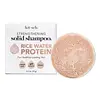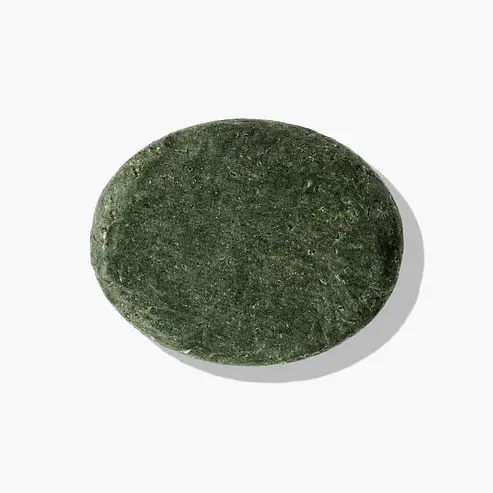What's inside
What's inside
 Key Ingredients
Key Ingredients

No key ingredients
 Benefits
Benefits

 Concerns
Concerns

 Ingredients Side-by-side
Ingredients Side-by-side

Sodium Cocoyl Isethionate
CleansingBehentrimonium Methosulfate
Cetearyl Alcohol
EmollientHydrogenated Coconut Acid
EmollientTheobroma Cacao Seed Butter
EmollientOryza Sativa Seed Water
AntimicrobialSodium Isethionate
CleansingGlycerin
HumectantWater
Skin ConditioningCetyl Alcohol
EmollientSimmondsia Chinensis Seed Wax
Skin ConditioningSodium Lactate
BufferingButyrospermum Parkii Butter
Skin ConditioningSaccharomyces Ferment
Skin ConditioningParfum
MaskingButylene Glycol
HumectantStearic Acid
CleansingOryza Sativa
Bambusa Vulgaris Leaf Extract
Skin ConditioningBrassica Oleracea Italica Seed Oil
EmollientCalcium Pantothenate
Inositol
HumectantOryza Sativa Bran Oil
EmollientHydrolyzed Vegetable Protein
Skin ConditioningTocopheryl Acetate
AntioxidantLeuconostoc/Radish Root Ferment Filtrate
AntimicrobialAloe Barbadensis Leaf Juice
Skin ConditioningMaltodextrin
AbsorbentJasminum Officinale Oil
MaskingLeuconostoc/Radish Root Ferment Lysate Filtrate
Skin ConditioningSodium Cocoyl Isethionate, Behentrimonium Methosulfate, Cetearyl Alcohol, Hydrogenated Coconut Acid, Theobroma Cacao Seed Butter, Oryza Sativa Seed Water, Sodium Isethionate, Glycerin, Water, Cetyl Alcohol, Simmondsia Chinensis Seed Wax, Sodium Lactate, Butyrospermum Parkii Butter, Saccharomyces Ferment, Parfum, Butylene Glycol, Stearic Acid, Oryza Sativa, Bambusa Vulgaris Leaf Extract, Brassica Oleracea Italica Seed Oil, Calcium Pantothenate, Inositol, Oryza Sativa Bran Oil, Hydrolyzed Vegetable Protein, Tocopheryl Acetate, Leuconostoc/Radish Root Ferment Filtrate, Aloe Barbadensis Leaf Juice, Maltodextrin, Jasminum Officinale Oil, Leuconostoc/Radish Root Ferment Lysate Filtrate
Ingredients Explained
These ingredients are found in both products.
Ingredients higher up in an ingredient list are typically present in a larger amount.
Glycerin is already naturally found in your skin. It helps moisturize and protect your skin.
A study from 2016 found glycerin to be more effective as a humectant than AHAs and hyaluronic acid.
As a humectant, it helps the skin stay hydrated by pulling moisture to your skin. The low molecular weight of glycerin allows it to pull moisture into the deeper layers of your skin.
Hydrated skin improves your skin barrier; Your skin barrier helps protect against irritants and bacteria.
Glycerin has also been found to have antimicrobial and antiviral properties. Due to these properties, glycerin is often used in wound and burn treatments.
In cosmetics, glycerin is usually derived from plants such as soybean or palm. However, it can also be sourced from animals, such as tallow or animal fat.
This ingredient is organic, colorless, odorless, and non-toxic.
Glycerin is the name for this ingredient in American English. British English uses Glycerol/Glycerine.
Learn more about GlycerinParfum is a catch-all term for an ingredient or more that is used to give a scent to products.
Also called "fragrance", this ingredient can be a blend of hundreds of chemicals or plant oils. This means every product with "fragrance" or "parfum" in the ingredients list is a different mixture.
For instance, Habanolide is a proprietary trade name for a specific aroma chemical. When used as a fragrance ingredient in cosmetics, most aroma chemicals fall under the broad labeling category of “FRAGRANCE” or “PARFUM” according to EU and US regulations.
The term 'parfum' or 'fragrance' is not regulated in many countries. In many cases, it is up to the brand to define this term.
For instance, many brands choose to label themselves as "fragrance-free" because they are not using synthetic fragrances. However, their products may still contain ingredients such as essential oils that are considered a fragrance by INCI standards.
One example is Calendula flower extract. Calendula is an essential oil that still imparts a scent or 'fragrance'.
Depending on the blend, the ingredients in the mixture can cause allergies and sensitivities on the skin. Some ingredients that are known EU allergens include linalool and citronellol.
Parfum can also be used to mask or cover an unpleasant scent.
The bottom line is: not all fragrances/parfum/ingredients are created equally. If you are worried about fragrances, we recommend taking a closer look at an ingredient. And of course, we always recommend speaking with a professional.
Learn more about ParfumSodium cocoyl isethionate is a natural ingredient from coconut oil. It is an ultra gentle cleanser that gives a nice foam without drying the skin or impacting the skin barrier.
The amount of foam created depends on the amount of sodium cocoyl isethionate used in the product.
This ingredient also helps improve the spreadability of a product.
Learn more about Sodium Cocoyl Isethionate